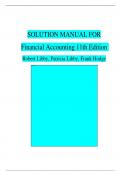Examen
Solution Manual for Financial Accounting 11th Edition Robert Libby, Patricia Libby, Complete Chapters 1 - 13, Verified Newest Version
- Cours
- Établissement
Solution Manual for Financial Accounting 11th Edition Robert Libby, Patricia Libby, Complete Chapters 1 - 13, Verified Newest Version
[Montrer plus]



